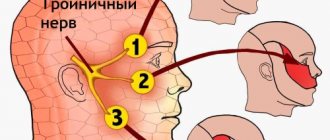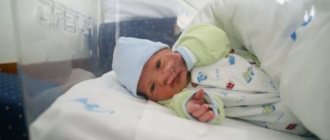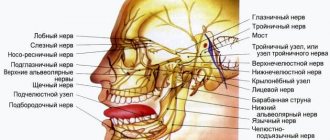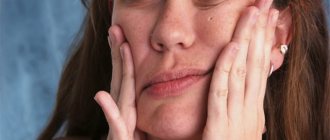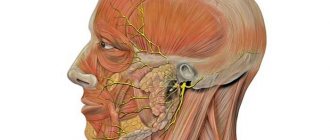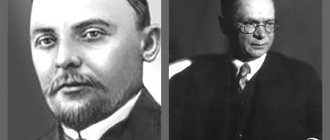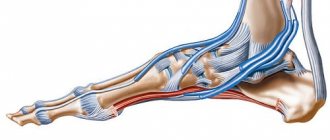Facial nerve neuropathy is a disorder in the transmission of nerve impulses along a nerve due to the death of its fibers. Paresis is weakness of the facial muscles , i.e. a consequence of nerve problems. Nervous eye tics are a common reason why patients visit a doctor in search of treatment. Treatment of nervous tic (hyperkinesis) of the eye in our clinic will be based on the cause of hyperkinesis. We specialize in treating neurological problems, including facial nerve treatment.
- Treatment of the facial nerve at the Echinacea clinic
- Restore the functioning of the facial nerve: the sooner, the more completely
- Symptoms of neuritis, neuropathy, inflammation of the facial nerve
- Neuralgia of the facial nerve
- Examination for facial nerve disease - find and eliminate the cause of the disease
- If treatment does not bring results. Synkinesia and facial contracture
- Facial hemispasm. Paraspasm. Blepharospasm
Treatment of the facial nerve at the Echinacea clinic
The treatment will be structured like this:
- Find and eliminate the factor that damaged the nerve (viruses, for example);
- Stimulate nerve regeneration.
If you neglect the first point, the chances of restoring the nerve are reduced, and the risk of facial contracture increases. The average duration of treatment is 2 months; you can complete most of the course at home on your own.
The planned result is restoration of the functioning of the facial muscles. Possible difficulties are advanced disease, significant narrowing of the facial nerve canal, damage to the myelin sheath of the nerve, leading to the appearance of a nervous tic of the eye, which to some extent complicates the treatment process. Read more about the causes and treatment of nervous tics.
Restore the functioning of the facial nerve: the sooner, the more completely
The sooner the cause of death of nerve fibers is eliminated, the faster the restoration of facial muscles will occur. Modern diagnostic methods almost always make it possible to find out the cause of the suffering of the facial nerve. We will perform almost any necessary examination.
| The cause of the girl's facial nerve paresis was an infection (asymptomatic sinusitis). On a computed tomogram: 1 – clean maxillary sinus (the air looks black on the image); 2 – the maxillary sinus is filled with pus. | The cause of facial nerve paresis in the man was foci of cerebral circulatory disorders. On an MRI scan, areas of impaired blood circulation appear lighter than healthy brain tissue and are marked with numbers 1 and 2. |
Simply stimulating the regeneration of the facial nerve is risky: facial symmetry may not be restored, facial contracture and synkinesis are possible. Finding and, if possible, eliminating the cause of nerve death is a condition for successful treatment .
Most often, we find one of four causes of facial paresis:
- Neuritis – inflammation of the facial nerve (usually involving viruses);
- Insufficient blood supply to the facial nerve or its brain centers (nuclei);
- Compression of the facial nerve in its bony canal (tumor, edema or injury to the temporal bone);
- Injury to the nerve or its brain centers.
Treatment of the facial nerve should be aimed at eliminating the cause of its suffering . Methods:
- In case of inflammation and swelling of the facial nerve, it swells and compresses itself in its narrow bony canal, and then dies from compression. This is precisely what is a common cause of facial paralysis. Therefore, in the acute period, we perform powerful anti-edematous treatment . Medicines can be prescribed orally, intravenously, or in the form of local blockades.
- Antiviral treatment and restoration of the immune system will help stop the destruction of the nerve when it is inflamed.
- The damaged area of the nerve needs building material for restoration. We will select medications that promote the supply of blood and nutrients to the nerve and its centers in the brain stem.
- Treatment by an ENT doctor if necessary (purulent or sluggish inflammatory process in the tonsils or ear, with damage to the nearby facial nerve).
For the most complete restoration of the facial nerve, it is very important to perform facial gymnastics and massage. Gymnastics and facial massage are needed daily. We will teach you to perform them yourself.
Features of the pathological process
Damage to the facial nerve, number 7 among the paired cranial nerve tracts, manifests itself in the form of muscle weakness (paresis) and numbness of the skin. In severe cases, this process is characterized by a complete loss of sensitivity on the affected side of the face (paralysis) and because of this, its asymmetry develops. The loss of taste is only partial, but this is why suspicions arise about compression of the hypoglossal nerve (12 pairs).
Often the pathology manifests itself on 1 side and, depending on the nature of its occurrence, can be primary or secondary. The first form occurs mainly due to hypothermia, and the second due to various factors, for example, infection, injury, etc.
For many people, pinching of the trigeminal nerve (5 pairs) is no different from compression of the facial nerve tract. However, there are also differences between them, for example, pair 7 has more sensory fibers, and pair 5 has more motor fibers. When pinched, such a nuance is difficult to distinguish, but with the help of modern instrumental examination methods, an experienced doctor will be able to do this.
Symptoms of neuritis, neuropathy, inflammation of the facial nerve
The essence of the symptoms is the disconnection from the brain of those areas whose function is controlled by the facial nerve:
- Weakness or paralysis of the facial muscles of one half of the face, which is expressed in the inability to raise the eyebrows, close the eyes, blink, wrinkle the nose, smile, puff out the cheeks (sail symptom); sometimes you feel the chin being pulled down, tension in the subcutaneous muscle of the neck;
- As a result of the disconnection of the facial muscles, a drooping of the corner of the mouth and smoothness of the nasolabial fold may be noticeable;
- As a result of the shutdown of the cheek muscles, it may be difficult to eat liquid foods;
- Sometimes the symptoms described above are accompanied by dry eyes or lacrimation, increased sensitivity to sounds (booming in the ear), decreased taste sensitivity, increased or decreased sensitivity of the facial skin on the affected side.
Neuralgia of the facial nerve
Neuralgia is a pain syndrome. The diagnosis of “facial neuralgia” is usually made incorrectly instead of the diagnosis of “trigeminal neuralgia”. The facial nerve contains only motor nerve fibers and does not transmit sensory impulses. Therefore, neuralgia, i.e. There is no pain in the facial nerve system. The facial nerve transmits commands from the brain to the facial muscles, and the symptoms of its suffering are weakness or paralysis of the facial muscles (facial nerve paresis).
Read more about trigeminal neuralgia
Causes
A pinched nerve can occur due to the following factors:
- Mechanical injuries (bruises, cuts, etc.);
- Inflammation of nerve fibers due to colds, infections or trauma;
- The growth of a benign formation (neurinoma) in close proximity to the facial nerve tract;
- Increasing intoxication of the body due to advanced diabetes mellitus;
- Pathologies of cerebral (brain) vessels;
- Using medications to block a nerve in the face, such as local anesthesia.
Damage to the facial nerve sometimes manifests itself for idiopathic reasons, that is, unknown. In this case, the doctor conducts a full examination to exclude a possible irritating factor.
Examination for facial nerve disease - find and eliminate the cause of the disease
The symptoms of facial nerve pain are almost the same in all cases, but its causes are different and require different treatments. Treatment “blindly” can delay the healing process. Therefore, in our clinic everything starts with searching for the exact cause and location of the nerve damage.
MRI of the brain, temporal bone. MRI scans show the brain centers of the facial nerve and its area of exit (root) to the base of the brain, blood vessels, and temporal bone. Circulatory disorders, cysts and tumors are easily recognized.
Blood tests to check for infections, biochemical changes that damage the facial nerve. The trigeminal nerve is a favorite area of attack by the herpes virus group. The suspicion of the presence of the virus and its activity can be easily verified using a blood test.
Electromyography, Blink reflex - measurement of electrical potentials of facial muscles. Helps assess the function of impulse transmission along the facial nerve, the degree of its impairment, judge the effectiveness of treatment, the presence of complications, and help in choosing the correct treatment tactics.
Stimulation electromyography of the facial nerve (electroneuromyography, myography of the facial nerve)
Diagnostics
Any experienced doctor can easily recognize a pinched nerve in the face, but sometimes there is compression of several nerve pathways, for example, the sublingual and facial. In such a situation, it is necessary to clarify this nuance using instrumental examination methods:
- Electroneurography;
- Study of evoked potentials (response to external stimulus);
- Electromyography.
Such methods will allow you to find out the location and extent of damage. They are also carried out to monitor the dynamics of restoration of nerve impulse transmission. However, before drawing up a course of treatment, it is necessary to exclude the secondary nature of the pathological process; for this, tomography (magnetic resonance and computer) is used. It will show the presence of abnormalities in the brain.
If treatment does not bring results. Synkinesia and facial contracture
Facial symmetry returns in an average of 3 months. If your treatment has not brought results, facial asymmetry persists, pain or other symptoms appear, you should immediately clarify the cause of the dysfunction of the facial nerve. The location and cause of the nerve injury may not have been recognized and treatment was prescribed blindly. Perhaps little attention was paid to restorative procedures.
Facial synkinesis is a condition when, for example, closing the eye is accompanied by movement of the mouth and cheek, and smiling is accompanied by closing the eye, etc. Synkinesis occurs more often in cases of long-term, chronic disease of the facial nerve. Most often in these cases we find a chronic inflammatory process in the area of the nerve bed.
The most problematic complication of facial paralysis is contracture, i.e. cicatricial degeneration of facial muscles. The result of contracture is loss of elasticity and immobilization of the facial muscles, even after the function of the facial nerve itself has been restored. Contracture appears as a result of prolonged untreated paralysis of the facial muscles and/or as a result of inadequate recovery procedures (insufficient intensity of exercise or, conversely, excessive stimulation of the facial muscles). Facial contracture is partially reversible. We usually use local injections of the anti-scar drug Longidaza: we inject it with a very thin needle directly into the area of scarring of the facial muscles.
Facial hemispasm. Paraspasm. Blepharospasm
These are diseases similar to diseases of the facial nerve. Even doctors often confuse them. We will definitely understand the causes of the disease and provide the necessary treatment.
Facial hemispasm is attacks of involuntary contraction or twitching of the facial muscles on one side, similar to a nervous tic of the eye (read more about the causes and treatment of neural tics (including the eyes) here). It may look like squinting, closing your eyes, retracting the corner of your mouth or tip of your nose, or lowering your chin. More information about nervous tics (including the eyes and its causes)
Facial paraspasm is an attack of involuntary contraction of facial muscles on both sides. It occurs much less frequently than hemispasm and more often has common causes with it. More details
Blepharospasm is a disease that begins with rapid blinking, which subsequently develops into intense uncontrolled squinting of the eye or both eyes. More details
We will be happy to help you find the cause and treatment of facial hemispasm (nervous tic of the eye), facial paraspasm, blepharospasm.
Possible consequences
In the absence of adequate treatment, all changes become irreversible within 6 months after the pathological change in the nerve endings. Serious complications include the formation of contracture, tightening of facial muscles, and involuntary pulsation.
The prognosis for entrapment of the facial nerve depends on the location of the lesion, the severity of the course, and the nature of its occurrence. With timely treatment, relief occurs in 80% of patients. If there is no positive dynamics for 6 months, then the risks of developing contractures increase significantly.
